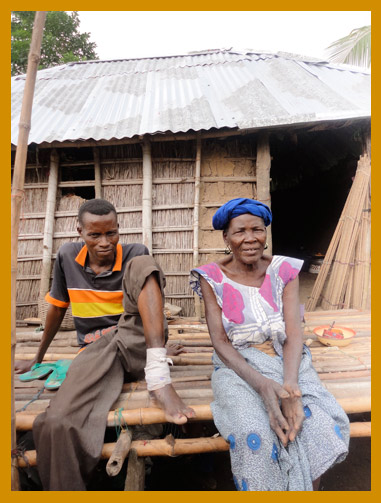CARE Human Interest Story Contest
“The Roof of Hope”
by Jenna Blumenthal

An elderly woman, Bodjigbé Yedjrohoundo (right), sits on her porch with her disabled son (left) in front of their new metal roof. CARE Benin/Togo's Emergency Response Operations project built the family a new roof after an atypical rainy season brought massive floods to the Ouémé River Valley in Benin last year.
About a fifteen-minute drive from Benin’s capital, Porto-Novo, lies the fertile Ouémé River Valley. It is here, not too far from the polluted streets of the city, that an atypical rainy season devastated the valley from August to October 2010. Navigating the river on a red and blue wooden boat, one can still see signs of destruction, such as the shaky foundation of a hut or high-water marks on schoolhouses.
As the boat anchors to the muddy riverbank of Agongué, a village in the commune of Dangbo, children run to the bank from nearly every direction. Although Dangbo has an estimated population of 60,055 inhabitants, the population of Agongué represents only a small fraction of the total population of the commune. We follow the children through narrow dirt paths to a house where a woman named Bodjigbé Yedjrohoundo lives.
We find Bodjigbé sitting on her porch attached to her thatched hut. Her skin is wrinkled and her teeth are yellow. Despite signs of old age, Bodjigbé has a grin on her face. She points to the silver, metal roof that CARE Benin/Togo recently installed on top of her hut. The metal sheets shine brilliantly in the afternoon sun.
Through an interpreter, Bodjigbé explains that she is helpless. Flooding devastated her village last year and destroyed her roof. Unable to repair the roof herself, Bodjigbé asked her son for help. However, he broke his left ankle last year and has been unable to seek medical attention. Several pieces of white gauze are still wrapped around it today.
Fifty-one out of the country’s 77 regions were affected by the intense flooding last year. The destruction that ensued is considered much worse than that caused by floods in 1963, which some consider as “the worst disaster that Benin has ever known.”
Since last year, CARE Benin/Togo has responded promptly to the needs of vulnerable people through their Emergency Response Operations project. The project, which is funded by The GATES Foundation and ELMA Philanthropies Services among many other donors, seeks to reduce the vulnerability of affected men, women, and children in six communes covering 108 villages. Through distributing water, food, and other basic necessities, CARE Benin/Togo has impacted 21,496 households or about 120,000 people.
Still, the organization’s job is far from over. Many houses are in serious need of repair as evidenced by gaping holes in the roofs of many straw huts throughout the intervention area. It is estimated that 4,756 houses have been entirely destroyed and 10,743 homes like Bodjigbé’s have been partially destroyed.
Under the direction of CARE Benin/Togo, a team of five volunteers helped to repair Bodjigbé’s roof. In return for their efforts, they received food rations through a food for work program. Bodjigbé, too, received a kit with the necessary supplies to repair her damaged roof, such as sheet metal. CARE Benin/Togo estimates that a total of 3,172 housing repair kits were distributed during the emergency response phase and 1,549 kits were distributed during the post-emergency phase.
“Right now, she and her son are happy with their new roof,” the interpreter said after translating Bodjigbé’s words from Fon, the local language, into French.
Bodjigbé also received a water purification and hygiene kit as well as a food kit, which included corn, beans, oil, and salt among other items. “I am so grateful to have received all of these kits,” said Bodjigbé with a smile on her face.
A few minutes from Bodjigbé’s house, in the center of the village, CARE Benin/Togo is also working to strengthen the community’s ability to adapt to floods in the future. The organization has begun working on thirty-one community shelters in the most vulnerable villages. The shelters will be constructed out of durable material in order to withstand future weather events. They are intended to provide each village with a space to organize and discuss issues, especially during bad weather conditions. Agongué’s community shelter is still in the early phases of construction. As of now, only six posts have been built out of concrete and metal. The roof and walls have not yet been built.
The Agongué village is trying to get the job finished before the end of the month when the rainy season is expected to start again. Although CARE Benin/Togo provides most of the project materials for the community shelters, the village is expected to contribute some supplies to the project. Currently, the community is trying to figure out how it will obtain sand. In general, there is still much more work to be done and time is quickly running out.
“If CARE Benin/Togo is able to offer any more help, that would make me really happy,” said Bodjigbé.
